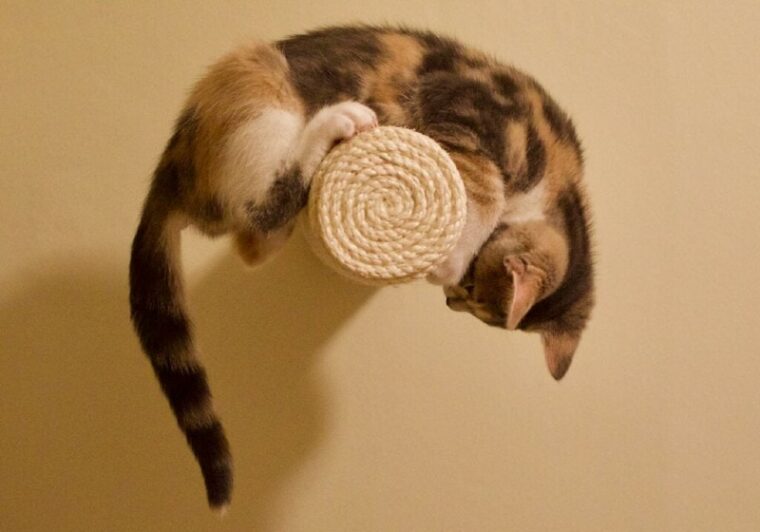
In stereotypes you may have seen on TV, dogs are more likely to chase their tails than cats. However, in reality, cats are also known to chase their tails for various reasons. A young kitten may see its tail swish by and become curious, pouncing on it as it would a toy. As entertaining as it might be to watch your cat chase their tail, it can occasionally be a sign of illness. Read on to see what you should do if you catch your cat chasing their tail.
The 4 Reasons Why Your Cat May Chase Its Tail
1. The Behavior Can Be Part of the Kitten Stage
Your young cat interacts with their world as they grow. Curiosity could compel them to chase their tails. They might mistake their tail for a toy, or even a snake, and decide to attack. Unlike most dogs, cats can actually catch their tails, and your kitten will be sorely disappointed if they decide to give their tail a swift bite. Most cats outgrow this behavior—we suspect after they’ve bitten their tails a time or two—but this behavior isn’t always limited to kittens.

2. Your Cat Is Anxious or Bored
Unusual behaviors often stem from boredom or anxiety about changing conditions. Working at the office, traveling, moving, or introducing new family members can cause your cat to go frantic with worry. If you’re gone from home for most of the day, your cat could take up tail chasing as a new hobby to help combat separation anxiety and boredom.
3. Your Cat Could Have an Infection in Its Tail
Unfortunately, it’s very easy for your cat to develop an infection in their tail. If your cat or another cat in its environment has bitten its tail in the past, your cat could be trying to catch their tail because it’s hurting them. This is more likely the case if your cat is displaying signs of agitation such as growling.
Allergies are another culprit behind tail infections and can have environmental or dietary causes. You might want to take your cat to the vet if it suddenly begins chasing its tail for no apparent reason and this behavior is accompanied by other unusual symptoms such as itchy skin, missing fur, or displaying obvious discomfort.

4. They Could Have Hyperesthesia Syndrome
Hyperesthesia syndrome is a rare disease involving multiple systems of your cat’s body. There are neurological effects, such as twitching, wriggling skin, and nerve pain. You shouldn’t assume your cat has hyperesthesia syndrome every time your cat grabs hold of their tail, but it’s definitely a condition that you should be aware of in case they start to show more symptoms.
Anxious cats display worse symptoms, which hints that it may have some behavioral causes. Their skin is affected too, which makes it a dermatological disorder. There might even be some genetic influences since certain breeds such as the Siamese are more likely to develop the disease.
During a hyperesthesia episode, your cat’s skin might ripple, and their pupils dilate as they appear to have a manic episode, grabbing their tail in a spastic manner and yowling. Cats usually show signs of pain if they’re touched during this time and may even try to bite you. Call your vet immediately if your cat appears to have hyperesthesia syndrome. Symptoms usually drastically improve with medicine.
How to Prevent Your Cat from Biting Their Tail
There’s no need for concern if your cat chases their tail with no sign of agitation. While it’s okay for them to merely chase their tails, you should redirect their attention to something else if they start biting their tails. It’s hard to cure a tail injury in cats, so you don’t want an open wound that can become infected. Additionally, don’t let cat siblings bite each other’s tails. If you start to notice this behavior, try to distract your cat by providing them with something stimulating that they can bite and chase, such as a catnip mouse.
Honestly, most cats outgrow tail chasing, especially if they end up biting their tails in the process. As your scratched hands know, kitty nibbles hurt, so they’ll probably drop the habit after they’ve succeeded a couple times.
If your cat keeps biting their tail, you should inspect their tails to see if you notice red skin or any injuries. Always take your cat to the vet if they suddenly act aggressive to you when you try to touch them, or if the tail chasing is accompanied by any other symptoms of hyperesthesia syndrome.
Conclusion
It’s normal for young kittens to chase their tails as they explore their environment. After all, they sort of have a built-in toy to hunt whenever they’re bored. However, your cat actually biting its tail isn’t usually okay. It’s almost always a sign that something is wrong with your cat. Obviously, it hurts your cat when they bite their own tail, and they’ll usually only do it when they’re trying to address an issue, such as itchy skin from allergies. Tail biting can even be an obsessive-compulsive disorder that your cat has adopted in order to cope with stress.
In rare cases, your cat may be showing signs of hyperesthesia, which is characterized by wriggling skin, dilated pupils, excessive excitability, and agitation. Take your cat to the vet if they start experiencing abnormal behaviors, or if you spot anything unusual about their tail.
Featured Image Credit: CarruthersCat, Shutterstock






